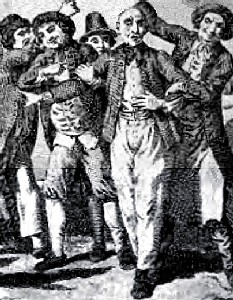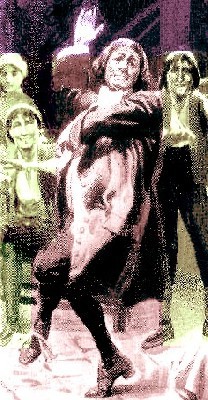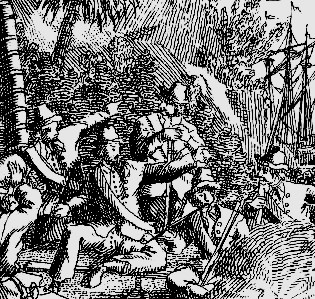
Christmas Holidays at Sea: 1 2 3 4 5 6 <<First
Christmas Holidays at Sea in the Golden Age of Piracy, Page 6
New Year's Day Celebrations at Sea
Let's finish with the way that New Year's was celebrated during this

The Annunciation, modified to fit your screen, by Leonardo da Vinci (1470s)
time period. Curiously, the holiday that goes hand-in-hand with Christmas in our culture, New Year's Eve/Day, is a different matter from Christmas altogether during the golden age of the pirates.
At this time, England, Wales and all the British dominions other than Scotland, started their new year on Lady Day - March 25th.1 Lady Day was the traditional name of the Feast of the Annunciation of the Blessed Virgin. It was likely chosen as the beginning of the New Year because it roughly coincides with the equinox.2 Curiously, as if they weren't sure whether the year had changed or not, various journal writers referred to the first three months of the year in the fashion 1708/9.3
The riotous celebration of New Year's Eve would have been completely alien to people alive during this time from my reading. No one mentions of there being any special festival or party of drinking to send out the old year.
New Year's Day gets but little attention by some of the period writers, even though it is not entirely clear that it would normally be a special day. Naval ship's chaplain Henry Teonge mentions something connected with New Year's Day, but it is nothing whatsoever like we think of the wild celebrations on the night before.

Image: Male Grignion
Admit it - This would be your response too.
Title: The Capture of Judge Jeffreys, from
The British Tar in Fact and Fiction, p. 18
(image date: 1688)
A NEW-YEARES GUIFT TO OUR CAPTAINE.
ACROSTICON.W—hen Phoebus did this morning first appeare,
I—nriching with his beames our hemispheare,
L—eaveing the darksum night behind him, and
L—onging to be at his meridian;
I—magine then the ould-yeare's out of date,
A—new on unto Jove lett's dedicate—
M—an should not bee like an ould almanacke,
H—eavens guide you, Sir, that Paules woords may be true,
O—uld things are doone a way, all things are newe;
U—nto the rich endowments of your mind,
L—ift up your noble courage: Fortune's kind
D—yrections bid you forwards; your Assistance
I—s beggd by Mars for th' Trypolees resistance.
N—eare man more fitt bould acts to undertake,
G—od with his blessings make you fortunate.
So prayes, H.T.4
George Parker Winship, writing in 1903 in his introduction to Lionel Wafer's Journal says that privateer Captain Sharp "sailed to the island of Juan Fernandez, where the labors of gathering wood, water, and goat meat were enlivened by the festivities of Christmas and New Year's."5 However, I didn't notice a mention of New Year's celebrations in the various accounts of Sharp's voyage so he may have been projecting modern conventions. (Or I may not have been reading as closely as I should.)
Our colorful friend Père Jean-Baptiste Labat mentions a New Year's celebration. The crew of the

A Pastoral Dance, from A Set of
Rogues,
by Frank Barrett, p. 355 (1895)
French ship Loire which he was aboard on New Year's Day, 1694 "saluted our captain and wished him a happy new year. All the ships [in the small fleet of French ships the Loire was traveling
with] did the same by firing their cannons, and M. de la Herroniere [the Loire's captain] fired 13 rounds to thank them."6 The other ship's captains came aboard, "heard Mass and we kept them to dinner. We ate some dolphin and other fish that our sailors had caught..."7 Of course, it must be remembered that this was a French vessel; the French celebrated January 1st as the start of the new year at that time.
The other New Year's celebration involves a group of privateers during the golden age of piracy. Although they took ships, privateers are another group of men who often get unfairly lumped in with pirates. There is an important distinction between the two. Privateers were given letters of marque by countries providing them permission to seize vessels of nations with which the issuing country was at war. Since the privateering ships were acting on behalf of the nation who issued the letter, it was 'legal' piracy - although only during war. It could be argued that privateers often turned pirate, but this was not always the case, so there is a distinction.
Back to New Year's Day - this is from Woodes Rogers' privateering account which details a January 1st celebration worthy of a group of rough and tumble sailors.
"This being New-Year's Day [1708], every Officer was wish'd a merry New-Year by our Musick; and I had a large Tub of Punch hot upon the Quarter-Deck, where every Man in the Ship had above a
Edward Lowe's Men Drinking, from Histoire der
Engelsche zee-roovers ( 1725) Pint to his share, and drank our Owners and Friends Healths in Great Britain, to a happy new Year, a good Voyage, and a safe Return. We bore down to our Consort, gave them three Huzza's, wishing them the like."8
However, that's the only account of a New Year's Celebration that I've come across to date. It may have been because Rogers' crew was unable to celebrate Christmas the week before; they had been locked in battle and the needs of the ship necessarily took precedence over the celebration of a holiday. It is also notable that this was the very first year of their 3 year privateering voyage, meaning they may have been fully stocked with supplies.
Whatever the case, it appears to have either been rare enough that this is the only account from that time to mention it. Either that or it was so common that no one else thought to mention it - although that seems unlikely.
1 New Year, wikipedia, gathered 11/20/12; 2 Lady Day, wikipedia, gathered 11/20/12; 3 See for example, The Diary of Henry Teonge, Chaplain on Board H.M.'s Ships Assistance, Bristol, and Royal Oak, 1675-1679; 4 Teonge,p. 129-30; 5 George Parker Winship, Introduction to Lionel Wafer's A New Voyage and Description of the Isthmus of America, p. 13;6 Père Jean-Baptiste Labat, The Memoirs of Pére Labat 1693-1705, translated and edited by John Eaden, p. 15; 7 Ibid; 8 Woodes Rogers, A Cruising Voyage Round the World, p. 61

